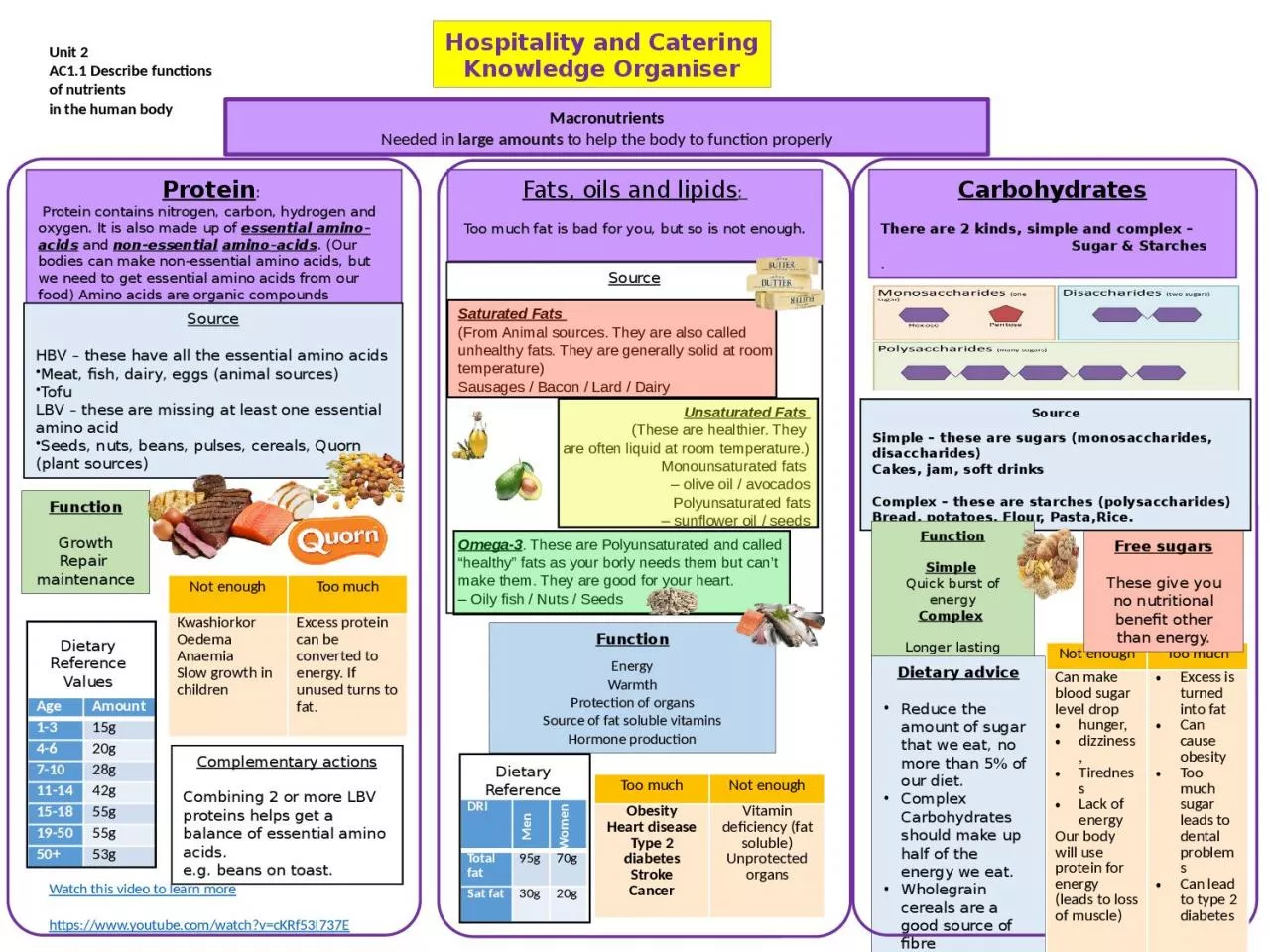

710 28g 1114 42g 1518 55g 1950 55g 50 53g Protein Protein contains nitrogen carbon hydrogen and oxygen It is also made up of essential amino acids and nonessential ID: 932862
Download Presentation The PPT/PDF document "Age Amount 1-3 15g 4-6 20g" is the property of its rightful owner. Permission is granted to download and print the materials on this web site for personal, non-commercial use only, and to display it on your personal computer provided you do not modify the materials and that you retain all copyright notices contained in the materials. By downloading content from our website, you accept the terms of this agreement.
Slide1
Age
Amount1-315g4-620g7-1028g11-1442g15-1855g19-5055g50+53g
Protein: Protein contains nitrogen, carbon, hydrogen and oxygen. It is also made up of essential amino–acids and non-essential amino–acids. (Our bodies can make non-essential amino acids, but we need to get essential amino acids from our food) Amino acids are organic compounds
SourceHBV – these have all the essential amino acidsMeat, fish, dairy, eggs (animal sources)TofuLBV – these are missing at least one essential amino acidSeeds, nuts, beans, pulses, cereals, Quorn (plant sources)
Complementary actionsCombining 2 or more LBV proteins helps get a balance of essential amino acids.e.g. beans on toast.
FunctionGrowthRepair maintenance
Dietary Reference Values
Fats, oils and lipids
: Too much fat is bad for you, but so is not enough.
SourceSaturated Fats (From Animal sources. They are also called unhealthy fats. They are generally solid at room temperature)Sausages / Bacon / Lard / DairyUnsaturated Fats (These are healthier. They are often liquid at room temperature.)Monounsaturated fats – olive oil / avocadosPolyunsaturated fats– sunflower oil / seeds Omega-3. These are Polyunsaturated and called “healthy” fats as your body needs them but can’t make them. They are good for your heart.– Oily fish / Nuts / Seeds
Function EnergyWarmthProtection of organsSource of fat soluble vitaminsHormone production
Dietary Reference Values
Carbohydrates
There are 2 kinds, simple and complex – Sugar & Starches.
SourceSimple – these are sugars (monosaccharides, disaccharides)Cakes, jam, soft drinks Complex – these are starches (polysaccharides)Bread, potatoes, Flour, Pasta,Rice.
FunctionSimple Quick burst of energyComplex Longer lasting energy
Dietary adviceReduce the amount of sugar that we eat, no more than 5% of our diet.Complex Carbohydrates should make up half of the energy we eat.Wholegrain cereals are a good source of fibre
DRI
Men Women Total fat95g70gSat fat 30g20g
`
Not enough
Too much
Can
make blood sugar level drop
hunger,
dizziness,
Tiredness
L
ack of energyOur body will use protein for energy (leads to loss of muscle)Excess is turned into fatCan cause obesityToo much sugar leads to dental problemsCan lead to type 2 diabetes
Too muchNot enoughObesityHeart diseaseType 2 diabetesStrokeCancerVitamin deficiency (fat soluble)Unprotected organs
Not enoughToo muchKwashiorkorOedemaAnaemiaSlow growth in childrenExcess protein can be converted to energy. If unused turns to fat.
Free sugarsThese give you no nutritional benefit other than energy.
Hospitality and Catering
Knowledge Organiser
Macronutrients
Needed in
large amounts
to help the body to function properly
Watch this video to learn more
https://www.youtube.com/watch?v=cKRf53I737E
Unit 2
AC1.1 Describe functions of nutrients
in the human body
Slide2Macronutrients
Needed in large amounts to help the body to function properlyFatFunction:EnergyWarmthProtection of organs SourcesSaturated Fat Unsaturated Fat (Bad Fats) (Good Fats)
Meat Avocado Processed Foods Nuts Lard Olive oilSaturated Fats - solid at room temperature and are from animal sources. Unsaturated fats are liquid at room temperature and are vegetable sources..
ProteinFunction:Growth and Repair
EnergySources:Plant Animal Nuts
EggsQuorn FishBeans
Meat
Lentils
CarbohydratesFunction:EnergyStarches: Sugars:Bread
CakesPasta Sweets
Rice Fizzy drinks
Wheat
PotatoesCereals
Too muchObesityType 2 diabetesHeart Disease
Too muchToo littleTurns to fat if not turned into energy
AnaemiaSlow growth in childrenToo Much
Tooth decayType two diabetes
ObesityWe should consume no more than 30g of sugar per dayMicronutrientsNeeded in small amounts to help the body to function properly
Vitamin
SourcesFunctions
Deficiency diseases
Vitamin A (fat soluble)Fish, eggs, orangesHelps with Eye sight and skin. It is also an antioxidant which protect the cells from harmful substance.
Night Blindness
Vitamin D (fat soluble)
Eggs, the sunHelps our bones to grow. Aids the absorption of Calcium and prevents RICKETS
Rickets in childrenOsteoporosis in women
Vitamin C (Water soluble)Oranges, tomatoes, vegetables
Helps to heal cuts, helps the immune system which prevents scurvy. Aids the absorption of Iron and prevents ANAEMIA Scurvy and AnaemiaB Vitamins (Water soluble)Cereals, meat, fishCreates enzymes that break down food allowing absorption of Carbohydrate, Fats and Protein into our blood.Beri Beri – lack of B1 - ThiaminPellagra - lack of B3 - NiacinHospitality and Catering Principals of Nutrition
Too muchToo littleObesity
Type 2 diabetesHeart DiseaseFat soluble vitamin deficiencieshttps://www.youtube.com/watch?v=ISZLTJH5lYg
Watch the video to learn more
The 5 main groupsThe Eatwell Guide divides the foods and drinks we consume into 5 main groups:fruit and vegetablespotatoes, bread, rice, pasta and other starchy carbohydratesbeans, pulses, fish, eggs, meat and other proteinsdairy and alternativesoils and spreadsYou should try to choose a variety of foods from each group to help you get the nutrients you need to stay healthy.Using the Eatwell
GuideYou can use this guide to help you make healthier choices when:planning what to eatcooking or preparing a meal at homefood shoppingeating out or on the goMost of the meals we eat are a combination of food groups. When planning meals, work out the main ingredients and think about how these fit within the 5 main food groups.
Watch the video to learn more
https://www.bbc.com/bitesize/clips/zxqjg82